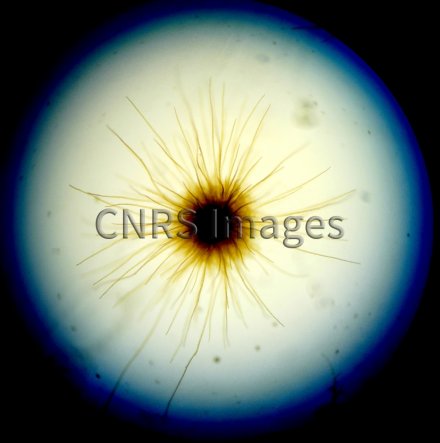Production year
2014

© Bénédicte Charrier / LBI2M / CNRS Images
20170086_0002
Thallus of the filamentous brown alga Ectocarpus siliculosus, measuring 2 mm in diameter, floating on the surface of a droplet of seawater, observed using a bright-field microscope. The Ectocarpus alga is used as a plant model, as it is easy to cultivate in the laboratory in small spaces, such as Petri dishes. It also has a short reproductive cycle of around six weeks. Its genome was the first brown alga genome to be sequenced. It has a simple morphology: the cells that make up its filaments are all accessible for observation and experimentation. As a result, research scientists are trying to identify the factors that control its morphogenesis (the biological process that generates the shape of an organism). To do this, they are trying to acquire several types of biological data: the biomechanical parameters of its surface (cell wall) using atomic force microscopy (AFM); the cell-dependent expression profile using laser capture microdissection (LCM) followed by RNA-Seq sequencing; and its growth dynamic using time-lapse microscopy and by labelling cell constituents such as the cytoskeleton, the wall and vesicular traffic. The results show that it is possible to simulate these processes by taking into account solely biophysical criteria, such as the internal pressure of cells, their shape, their rigidity and the thickness of their wall. In addition, an original apical growth strategy different to that used by other eukaryotic organisms studied has been observed in Ectocarpus filaments.
The use of media visible on the CNRS Images Platform can be granted on request. Any reproduction or representation is forbidden without prior authorization from CNRS Images (except for resources under Creative Commons license).
No modification of an image may be made without the prior consent of CNRS Images.
No use of an image for advertising purposes or distribution to a third party may be made without the prior agreement of CNRS Images.
For more information, please consult our general conditions
2014
Our work is guided by the way scientists question the world around them and we translate their research into images to help people to understand the world better and to awaken their curiosity and wonderment.